by Rick O'Connor | Sep 21, 2015
A portion of the Aucilla River flows through a landscape of dramatic and unusual geologic formations. Join us for this tour to see an amazing sequence of sinks and river rises, created as the river alternately disappears into the underlying karst and resurfaces. Fringed with moss-draped trees and native palms, the sinks are pools of black water easily viewed by walking the surrounding embankments along a 4.5 mile-segment of the Florida National Scenic Trail.
Your guides will cover the human history of this wildlife-rich Aucilla River landscape, which extends back 12,000 years to the Pleistocene epoc when mastodons, saber-tooth tigers and other large mammals roamed a landscape that resembled the African savannahs of today. The 1983 unearthing of a 12,000-year old mastodon tusk exhibiting cut marks— evidence of slaughter by humans — provides some of the earliest known evidence of man on this continent.
When: Wednesday, September 30th 2015 ● 10:00 am – 4:00 pm EDT
Where: meet at JR’s Aucilla River Store, 23485 US 98, Lamont, FL 32336 (east of the Aucilla River bridge, the boundary between Jefferson and Taylor counties)
Bring: comfortable hiking boots/shoes, weather-appropriate clothing, hiking stick or trekking pole, water bottle, bug spray, day pack; lunch prepared by Tupelo’s Bakery in Monticello will be provided
Cost: $25.00 per adult
Register at: http://uf-extension-pol-2015-aucilla-sinks-hike.eventbrite.com
Space is limited.
Please feel free to share this announcement and attached flyer with those you know who may be interested. And we hope you can join us for this trip if you’ve never seen this beautiful, mysterious place.
Will Sheftall, for Extension Natural Resource Agents in the Panhandle
sheftall@ufl.edu
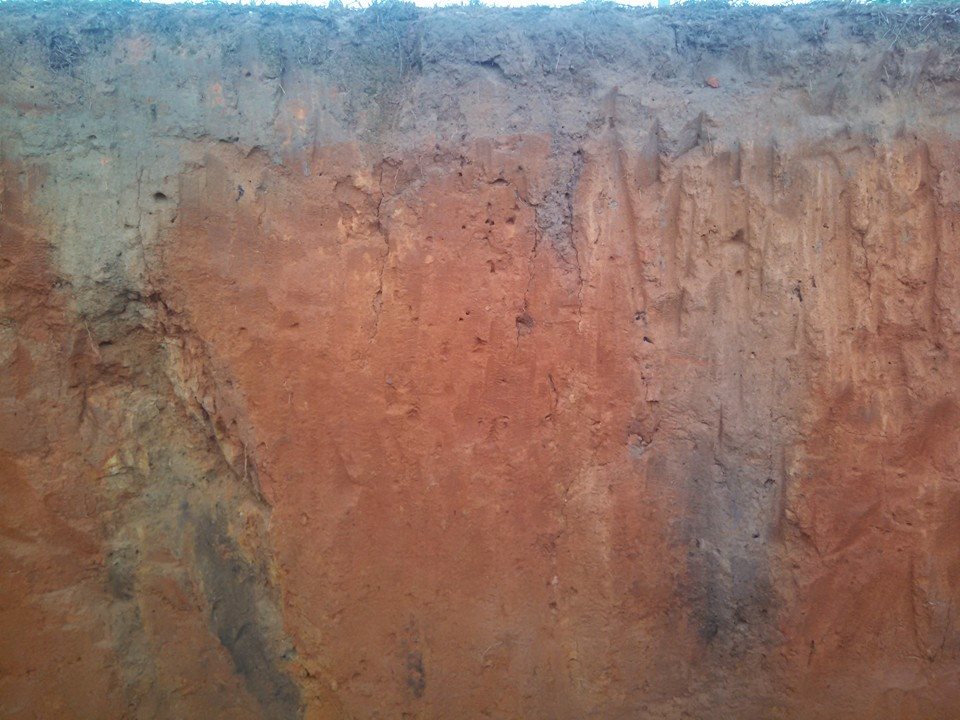
by Jennifer Bearden | Jan 16, 2015
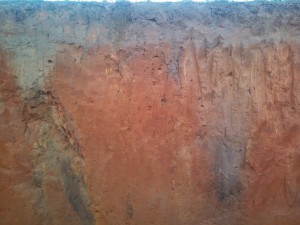
Soil Profile in Gadsden County. Photo by Jennifer Bearden
Many of us walk around daily and give no thought to what is under our feet. We do not consider soil a vital natural resource, but it is. And as with water and air, soil quality is very important to our society. Soils perform 6 functions in our ecosystems.
First it is a medium for plant growth. Plants root into the soil structure and stabilize the plant above ground. It holds nutrients, air, and water which the plants need.
Next, our soils regulate water supplies. Soil quality affects water quality. Contaminants and excess nutrients in poor soils can leach into groundwater. On the other hand, soils can purify poor quality water before it recharges groundwater supplies such as in septic tanks or rain gardens.
Soils also recycle nutrients needed for plant growth. If soils did not perform this function, plants and animals would exhaust the nutrients and there would be an increase in waste in our ecosystems.
Soils provide habitat for numerous organisms. An amazing amount of soil organisms exist hidden from our view. Earthworms, microscopic worms, bacteria, fungi and more call our soils home. These organisms play an important role in keeping our soils productive and our fields yielding crops.
Soils are also used as an engineering medium. For many years, humans have used soils to build and construct homes, roads, pottery and more. Just think of the roads and buildings that would not be here if we did not have soils.
Lastly, soils actually modify the chemical composition of the atmosphere. Air is a major component of our soils and it exchanges gases that are necessary for plant growth and microorganism survival. Also, dry, small soil particles can be picked up by winds causing human health concerns due to dust in the air we breathe.
So, is dirt just dirt or is it much more? I contend that without it, we would not be here today. So when you walk around today, consider the soil under your feet. It will not take long and you will see that soil surrounds us every day and is a very important natural resource.
by Les Harrison | May 19, 2013
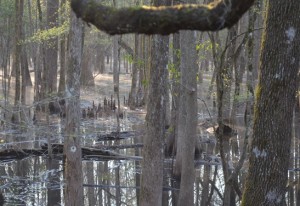
Swamps provide valuable filtration for surface water
Recent rains have left water standing on some panhandle Florida real estate which has been dry for several years. Ponds, natural and dug, are brimming with water reflecting the generous outpouring from the slow and wet weather system which passed listlessly over the area.
The rainwater excess is also filling the natural low points known as swamps or wetlands.
A swamp is defined as a forested wetland. Some occur along the floodplain of rivers, where they are dependent upon surplus flow from upstream and local runoff.
Other swamps appear adjacent to ponds in shallow depressions which fill during wet periods. Their landscape is covered by aquatic vegetation or trees and plants which tolerate periodical inundation.
Historically, swamps have an image problem. Legend has all sorts of unsavory creatures, degenerates, and ghosts inhabiting the locale waiting for the unsuspecting traveler.
Even the proper British used the term as a pejorative to describe Francis Marion during the American Revolution. The Swamp Fox engaged in guerilla warfare against the conventional forces and hid in the swamps to avoid capture.
Economically, these watery regions have had very low values. Their only significance was as site for trapping, hunting or for logging in dry years.
Medically, swamps were seen as a quick and painful way to the grave. There were all those creatures which could inflict pain; leeches, snakes, gators and the like.
Then there was disease. As an example, the term Malaria originated from the swamps of southern Europe where it meant bad air in medieval Italian. The mosquito connection was unknown until the early 20th Century.
Hollywood piled on the problem with a series of swamp monster movies. One, “The Creature from the Black Lagoon” was partially filmed at Wakulla Springs in the panhandle.
Reality, as is often the case, is quite different than the initial perception. Even the term swamp has fallen out of favor in some circles, being replaced with wetlands.
Swamps or wetlands serve a variety of functions in north Florida. Possibly the most critical is as a filtration system for the water table.
Excess rain is held in these shallow depressions and allowed to percolate or filter slowly through the soil. The screening effect of the soil and subsoil layers along with the slow progression cleanses the water of numerous impurities from the surface.
Without the holding capacity of local swamp, most rainwater would end up in streams and rivers. In addition to being a loss for the water table, the excess water would cloud waterways with a glut of surface debris and nutrients.
It is true mosquitos favor the still swamp waters, but so do many birds, fish and animals. Swamp rookeries are the nesting home for many wading birds. Mosquito larvae are an important link in the food chain which supports much of the life in the swamp, and beyond.
Even some of the swamp’s most ostracized residents, snakes, have an important part to play in the overall environmental balance. These reptiles control the population of many destructive insects and rodents.
To learn more about the importance of Panhandle Florida’s swamps and wetland, contact your UF/IFAS Extension Office.
by Judy Biss | Apr 13, 2013
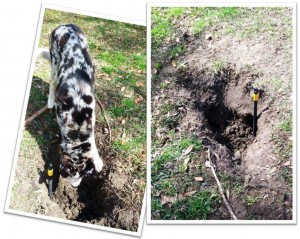
This tiny sinkhole appeared in my yard during the heavy March rains. Although only 3 feet wide, it was 5 feet deep. My dog looks both curious and jealous that it wasn’t one of the holes he’s dug!
During our heavy March rainfall events a tiny sinkhole appeared in my yard. While it was only 3 feet across, it was over 5 feet deep! After reading about the various types and causes of sinkholes, I decided it was most likely a “subsidence incident” sinkhole caused from collapsed underlying organic material (perhaps an old tree root?). Read on to learn more about sinkholes, their causes, and their prevalence in Florida.
Sinkholes are a fascinating, common, and sometimes tragic characteristic of Florida’s landscape. They are one feature of “karst” terrain which is quite prevalent in Florida. Other features of karst terrain include caves, springs, disappearing streams, and underground drainage systems. Karst terrain “is a type of topography that is formed by dissolution of bedrock in areas underlain by limestone, dolostone or, as in some western states, gypsum….The term karst, therefore, refers to the terrain and the term sinkhole is one of the types of drainage features reflected by that type of terrain. Other subterranean events can cause holes, depressions or subsidence of the land surface that may mimic sinkhole activity. These include subsurface expansive clay or organic layers which compress as water is removed, collapsed or broken sewer and drain pipes or broken septic tanks, improperly compacted soil after excavation work, and even buried trash, logs and other debris… Such an event is called a “subsidence incident.” (Source: Florida Dept of Environmental Protection http://dep.state.fl.us/geology/geologictopics/sinkhole.htm)
According to the United States Geological Survey and the Florida DEP Bureau of Geology, panhandle Florida’s limestone bedrock is overlain with from zero to over 200 feet of sediments. The depths and types of these overlying sediments are major factors in the prevalence and characteristics of sinkholes and other karst features. View this map to see an overview of sediment depth and sinkhole activity in your county. Leon County, in eastern panhandle Florida, boasts its geologically active Lake Jackson, not only for its famous largemouth bass fishery, but also for its periodic disappearances through underlying sinkholes! This 4,000 acre lake has a history of virtually draining through underlying sinkholes about every 25 years. Its most recent draining event was in 2006.
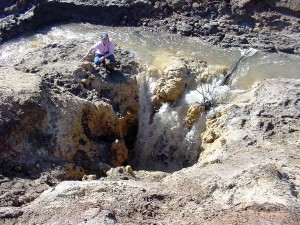
This is the sinkhole that drained Leon County’s Lake Jackson in 2006. The author is kneeling at its edge.
Please visit the following links for more information, including answers to questions such as:
- I think I have a sinkhole in my yard. What should I do?
- How do I fill in a sinkhole?
- Will watering our lawn lower the water table level and thus, cause sinkholes to develop in our neighborhood?
- Is there a government agency that will come and inspect my sinkhole?
- What is the sinkhole risk factor associated with my area?
- Is there a database showing all sinkholes in Florida?
- Our insurance company has informed us that the area where we are going to purchase property is listed as a sinkhole area. What does this mean? What can we do about it? Should we buy in that area?
Florida DEP, Bureau of Geology, All about Sinkholes, Questions and Answers.
Sinkhole Type, Development, and Distribution in Florida – A Map
UF/IFAS Disaster Handbook – Sinkholes
Sinkholes and Catastrophic Ground Collapse: What Every Floridian Should Know





